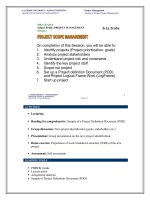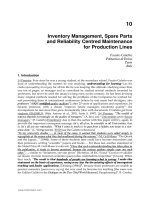Charter 2 inventory management
Bạn đang xem bản rút gọn của tài liệu. Xem và tải ngay bản đầy đủ của tài liệu tại đây (2.36 MB, 112 trang )
Charter 2
INVENTORY MANAGEMENT
Mã MH : 704015
Bộ môn: KDQT- K.QTKD
GV : Phạm Thị Ngân
Learning objectives
- Describe the different types and use of inventory;
- Describe the objectives of inventory management;
- Calculate inventory performance measures;
- Understand relevant costs associated with inventory;
- Calculate order quantities;
- Understand how to justify smaller order sizes;
- Calculate appropriate safety stock inventory policies;
- Calculate order quantities for single-period inventory;
- Perform ABC inventory control and analysis;
- Understand the role of cycle counting in inventory record accuracy
12/7/2016 704015- Chapter 2 Inventory Management 2
2.1 Inventory introduction
12/7/2016 704015- Chapter 2 Inventory Management 3
Types of inventory
Raw materials – purchased items or extracted materials
transformed into components or products;
Components – parts or subassemblies used in final
product
Work-in-process – items in process throughout the plant
Finished goods – products sold to customers
Distribution inventory – finished goods in the distribution
system
12/7/2016 704015- Chapter 2 Inventory Management 4
Types of Inventory
© Wiley 2007
Why Is Inventory Required?
Anticipation or seasonal inventory
Fluctuation Inventory or Safety stock: buffer demand
fluctuations
Lot-size or cycle stock: take advantage of quantity
discounts or purchasing efficiencies
Transportation or Pipeline inventory
Speculative or hedge inventory protects against some
future event, e.g. labor strike
Maintenance, repair, and operating (MRO) inventories
12/7/2016 704015- Chapter 2 Inventory Management 6
Objectives of Inventory
Management
• Provide desired customer service level
• Customer service is the ability to satisfy customer
requirements
– Percentage of orders shipped on schedule
– Percentage of line items shipped on schedule
– Percentage of dollar volume shipped on schedule
– Idle time due to material and component
shortages
© Wiley 2007
Inventory Management Objectives
Provide for cost-efficient operations:
– Buffer stock for smooth production flow
– Maintain a level work force
– Allowing longer production runs & quantity
discounts
• Minimum inventory investments:
– Inventory turnover
– Weeks, days, or hours of supply
© Wiley 2007
• Hệ số vòng quay hàng tồn kho = Doanh thu / Giá trị
kho trung bình
• Ví dụ: Doanh thu cửa hàng của bạn trong năm 2019 là 900
triệu đồng, giá trị tồn kho trung bình là 30 triệu đồng.
• Hệ số vòng quay(inventory turnover: 900.000.000 /
30.000.000 = 30
• Như vậy trong năm 2019 cửa hàng của bạn đã quay vòng
hàng tồn kho 30 lần.
• Tiếp theo, lấy 365 ngày / 30 lần = 12,17 ngày. Nghĩa là
trung bình khoảng 12,17 ngày cửa hàng của bạn sẽ hết 1
vòng quay tồn kho. Dựa vào con số này bạn có thể ước tính
12/7/t20r1ư6 ớc thời gian sắp 7h04ế015t- Chhapàtenr 2gInveđntoểry Mcaónagekmeếnt hoạch nhập hàng phù9
DICUSSION
• What are the factors that affect inventory policy?
- Demand
- Leadtime;
- Quantity; types of goods
- Holding cost; setup cost/ordering cost
- Service level
12/7/2016 704015- Chapter 2 Inventory Management 10
Holding costs
Holding Category Cost (and range)
Costs Housing costs (building rent or as a Percent of
depreciation, operating costs, taxes, Inventory Value
12/7/2016 insurance) 6% (3 - 10%)
Material handling costs (equipment lease or
depreciation, power, operating cost) 3% (1 - 3.5%)
Labor cost
Investment costs (borrowing costs, taxes, 3% (3 - 5%)
and insurance on inventory) 11% (6 - 24%)
Pilferage, space, and obsolescence
3% (2 - 5%)
Overall carrying cost 26%
704015- Chapter 2 Inventory Management Table 12.1 11
Setup costs/ordering costs
12/7/2016 704015- Chapter 2 Inventory Management 12
2.2 Single Stage Inventory Control
• Single supply chain stage
• Variety of techniques
– Economic Lot Size Model
– Demand Uncertainty
– Single Period Models
– Initial Inventory
– Multiple Order Opportunities
– Continuous Review Policy
– Variable Lead Times
– Periodic Review Policy
– Service Level Optimization
12/7/2016 704015- Chapter 2 Inventory Management 13
2.2.1 EOQ model
What is EOQ model?
Economic order
quantity (EOQ) is the
order quantity that
minimizes the total
holding costs and
ordering costs.
12/7/2016 704015- Chapter 2 Inventory Management 14
EOQ model (cont)
Important assumptions
1. Demand is known, constant, and independent
2. Lead time is known and constant
3. Receipt of inventory is instantaneous and complete
4. Quantity discounts are not possible
5. Only variable costs are setup and holding
6. Stock outs can be completely avoided
12/7/2016 704015- Chapter 2 Inventory Management 15
EOQ model (cont)
Order Usage rate Average
quantity = Q inventory
Inventory level (maximum on hand
inventory Q
level) 2
Minimum
inventory
0
Time
Inventory Usage Over Time
12/7/2016 704015- Chapter 2 Inventory Management 16
EOQ model (cont)
Objective is to minimize total costs
Total cost of
holding and
setup (order)
Minimum
total cost
Annual cost Holding cost
Setup (or order)
cost
Optimal Order quantity
order
Table 12.4(c) quantity (Q*)
12/7/2016 704015- Chapter 2 Inventory Management 17
EOQ model (cont)
Q= Number of pieces per order Annual setup cost = DQ S
Q* = Optimal number of pieces per order (EOQ)
D= Annual demand in units for the inventory item
S= Setup or ordering cost for each order
H= Holding or carrying cost per unit per year
Annual setup cost = (Number of orders placed per year)
x (Setup or order cost per order)
= Annual demand Setup or order Number of units in each order cost per order
= DQ (S)
12/7/2016 704015- Chapter 2 Inventory Management 18
EOQ model (cont)
Q = Number of pieces per order Annual setup cost = DQ S
Q* = Optimal number of pieces per order (EOQ) Annual holding cost = Q H
D = Annual demand in units for the inventory item
2
S = Setup or ordering cost for each order
H = Holding or carrying cost per unit per year
Annual holding cost = (Average inventory level)
x (Holding cost per unit per year)
= Order quantity (Holding cost per unit per year)
2
= Q2 (H)
12/7/2016 704015- Chapter 2 Inventory Management 19
The EOQ Model(cont)
Q = Number of pieces per order
Q* = Optimal number of pieces per order (EOQ)
D = Annual demand in units for the inventory item
S = Setup or ordering cost for each order
H = Holding or carrying cost per unit per year
Optimal order quantity is found when annual setup cost
equals annual holding cost
Solving for Q* DQ S = Q2 H Annual setup cost = DQ S
Annual holding cost = Q H
2DS = Q2H
Q2 = 2DS/H 2
Q* = 2DS/H 20
12/7/2016 704015- Chapter 2 Inventory Management









